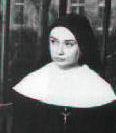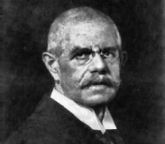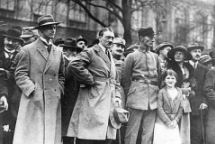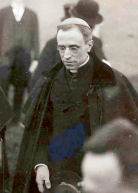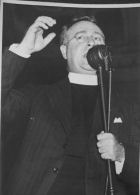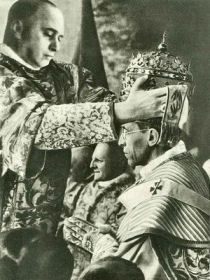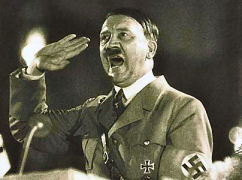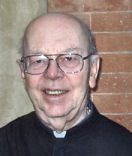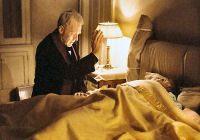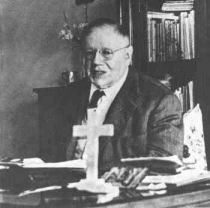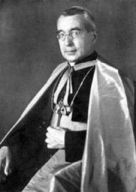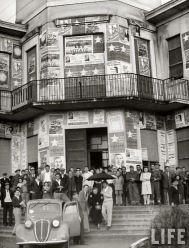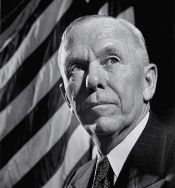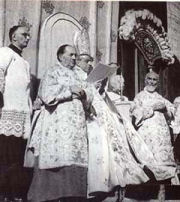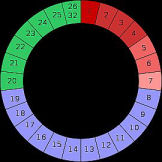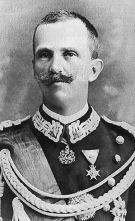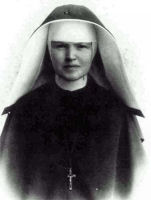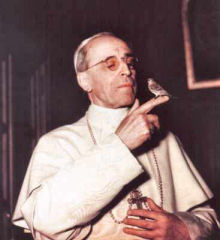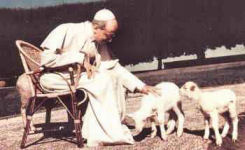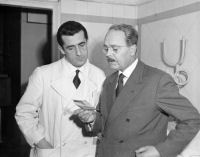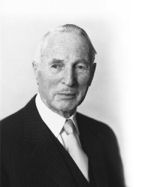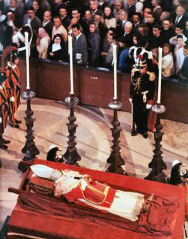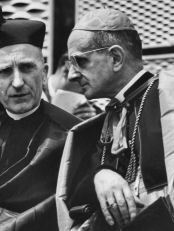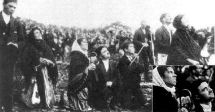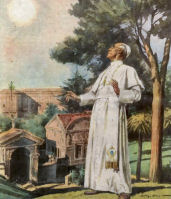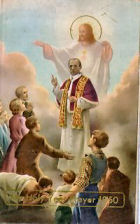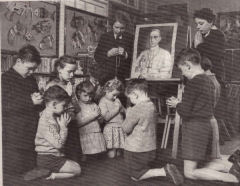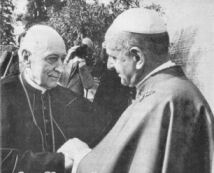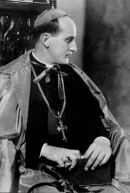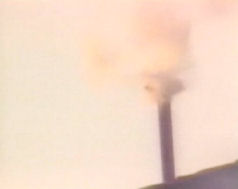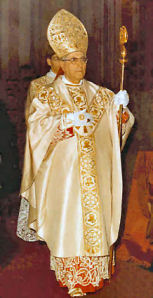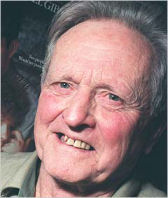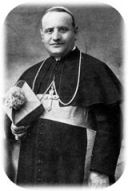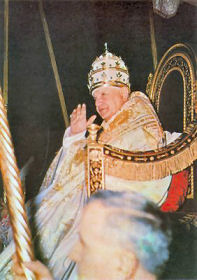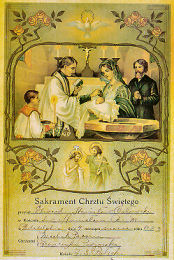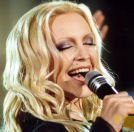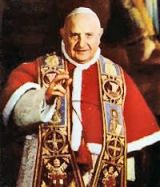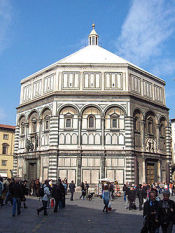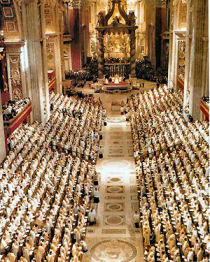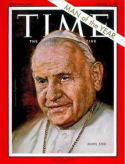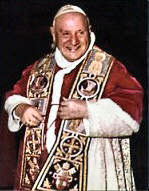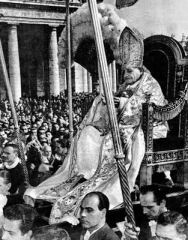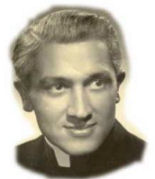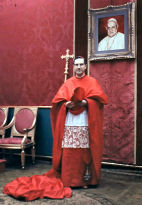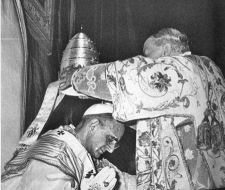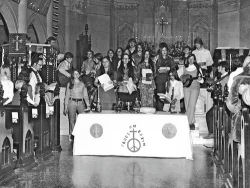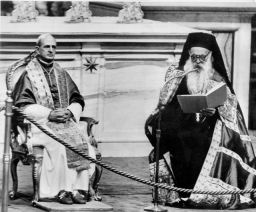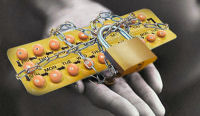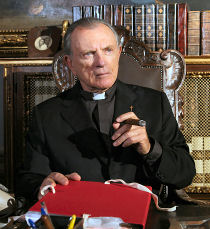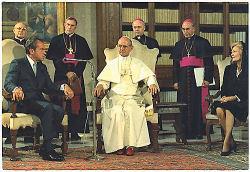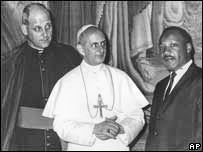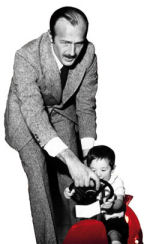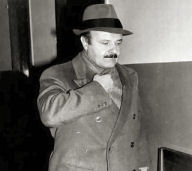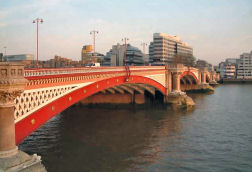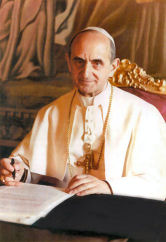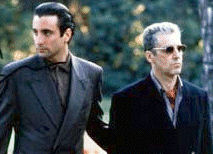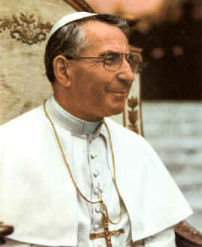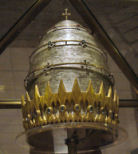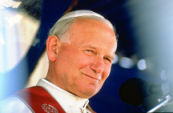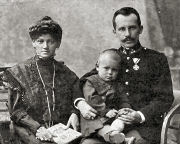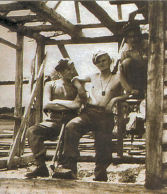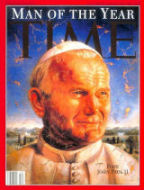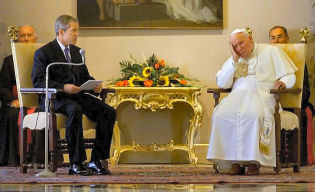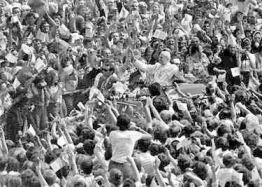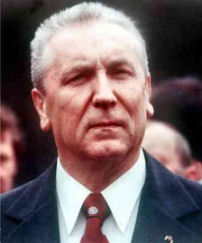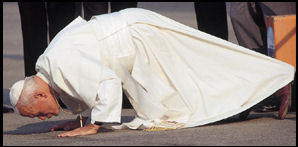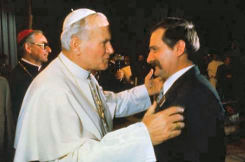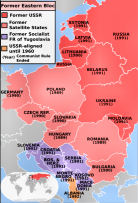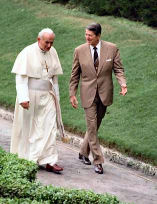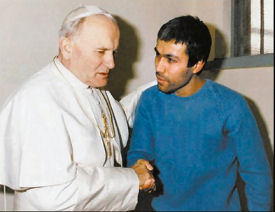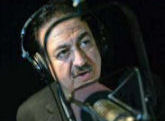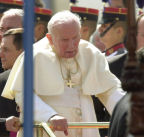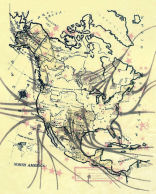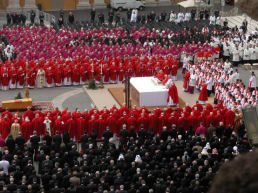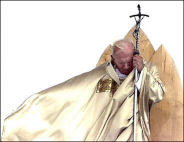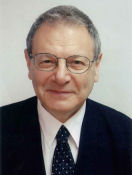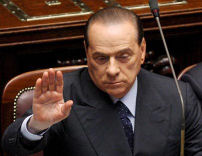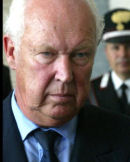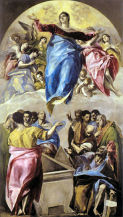Chapter 24: Sr. Mary Immaculata’s Popes
The Worst Job in the World
Pope Pius XI died suddenly in 1939. Europe’s attention was focused on the Nazis, and nobody understood them better than Cardinal Eugenio Maria Giuseppe Giovanni Pacelli, the pope’s Secretary of State. From 1917 until 1930 he had been the de facto papal nuncio in Germany. On the night of the “Beer Hall Putsch” in 1923, Franz Matt, the only cabinet member who was absent from the Bürgerbräu Keller, was dining with Cardinal Pacelli and Cardinal von Faulhaber. The trio’s decisive action foiled the attempted coup.
Even after returning to the Vatican, Pacelli exerted a powerful influence over Catholic policy in Germany. In 1932 he advised the Catholic German Centre Party to join the Nazis in a coalition to thwart the Bolsheviks. Adolph Hitler became Chancellor on January 30, 1933. The Centre party even consented to his dictatorial powers. The Nazis signed a concordat with the Vatican in exchange for dissolution of the Centre party. Violations of this pact with the devil enraged Pacelli. He issued fifty-five protests and was also largely responsible for the text of Pius XI’s famous encyclical “Mit Brennender Sorge.” In the autumn of 1936 Cardinal Pacelli visited the United States. Two days after Roosevelt had won reelection, the pair lunched together in Washington. Some have speculated that one objective of the trip had been to pressure American Church officials to restrain Fr. Charles Coughlin. Coughlin certainly blamed Pacelli for his subsequent fall from grace. Cardinal Pacelli was quickly elected pope on March 2, 1939. When he received the tiara on his sixty-third birthday, he selected the name Pius XII. He had worked in and for the Curia for thirty-eight years, and his family had been involved with the papacy long before that. His final assignment was arguably the worst job in the world. From his headquarters in the heart of Fascist Italy he oversaw the Church’s struggle with the Nazis, the Fascists, and the Communists. The first two governed large Catholic populations, and both der Führer and il Duce repeatedly took advantage of this situation. Germany protested Pacelli’s election. Hitler evidently fantasized that the cardinals might choose someone less hostile. In actuality, Pius XII consistently strove to maintain neutrality, as Benedict XV had during World War I. In Benedict’s war, however, atrocities were roughly equally distributed among the participants. Pius XII never issued the encyclical prepared by Fr. LaFarge for his predecessor, and his reluctance to criticize the horrendous abuses of the German, Croatian, Slovakian, and Italian governments and the Pétain government in France provoked heated criticism.On the other hand, Pope Pius was instrumental in saving individual Jews. In the Vatican itself 477 Jews were hidden,[1] and over four thousand were protected in churches and convents. The Vatican also worked behind the scenes to save others. Some have acclaimed Pius XII as a great saint who rescued persecuted people and tactfully prevented worse atrocities. His critics have accused him of facilitating, wittingly or unwittingly, unspeakable monsters. This issue is more complicated than it might seem. Pope Pius walked a tightrope. As the leader of the Catholic Church, the last thing that he wanted was for the Nazis to lump Catholics with Jews, Gypsies, and other undesirables. Furthermore, no responsible pontiff could discount the possibility that the Axis nations might ultimately prevail; they came perilously close.
According to Vatican exorcist Father Gabriele Amorth, Pope Pius attributed Hitler’s evil ways to possession by Satan. Vatican documents reported in The Daily Mail of August 28, 2006, described the pope’s attempt at a long-distance exorcism rite on Hitler. Father Amorth explained the failure: “One of the key requirements for an exorcism is to be present in front of the possessed person, and that person also has to be consenting and willing. Therefore trying to carry out an exorcism on someone who is not present, or consenting and willing would prove very difficult.”Postwar Poping
When the Germans invaded Italy in 1943, Rome’s Chief Rabbi, Israel Zolli, took refuge in the Vatican. After the war the Jewish community rejected him. He converted to Catholicism in February of 1945 and took the name Eugenio, the pope’s own baptismal name. Zolli claimed that Christ had appeared to him to reveal that he (Zolli) was celebrating Yom Kippur for the last time. Evidently no one asked the rabbi how he recognized the prophetic Figure. Pope Pius XII undeniably tried to help war criminals avoid justice. He lobbied for clemency for all participants in the war. He even worked for pardons for some condemned to death for war crimes. More disturbing is the papacy’s alleged involvement in the “Ratline,” an operation run from the Vatican by a Roman Catholic bishop, Alois Hudal. Hudal sought out war criminals — including such notorious figures as Klaus Barbie, Adolf Eichmann, Heinrich Mueller, and Franz Stangl — and aided their escapes to South America and elsewhere. Did the pope know about this scandalous enterprise right under his nose?Using previously unavailable material from the Public Record Office in England and from the U.S. National Archives and Record Administration, Uki Goñi clearly demonstrates that Pius knew that ecclesiastical institutions in Rome were hiding war criminals. “The British dossiers...show that the pope secretly pleaded with Washington and London on behalf of notorious criminals and Nazi collaborators,” Goñi writes.[2]
Pope Pius never feigned neutrality toward Communism, a potent force in postwar Italian politics. He excommunicated all Italian Catholics who supported Communist candidates in the 1948 Italian elections. He also encouraged Azione Cattolica, a group legally barred from involvement in Italian politics, to support the conservative Christian Democrats. He was not alone; in an effort to influence the election, the U.S. posted ten million letters, broadcast short-wave radio propaganda, and distributed literature warning Italians of the Communist menace. The CIA also funded the center-right political parties and was accused of publishing forged letters discrediting leaders of the Italian Communist Party. On March 28 General Marshall warned that economic aid would be terminated if the Communists won. In the weeks before the elections American warships anchored menacingly in the principal Italian ports.The Christian Democrats won the election, but 31 percent of the voters favored the Communists. That’s a lot of excommunications.
Pius XII’s Encyclicals
Pope Pius XII’s writings mostly concerned politics, but several in other areas also merit scrutiny. In 1942 he became the second pope to augment the Catholic Creed through an infallible decree. His apostolic constitution, “Munificentissimus Deus,” declared it an article of faith that Mary, Jesus’s mother, was assumed bodily into heaven (the Assumption). Just as Pius IX had endorsed the Immaculate Conception without referencing scripture, so also was the Assumption inferred from “sacred tradition.” A very peculiar aspect of this tradition is that its geographic location is disputed; Ephesus and Jerusalem have supporters. If an archeological expedition ever locates Mary’s grave, the Church is bound to contest the evidence. In 1951 Pope Pius endorsed the Big Bang theory as consistent with both tradition and dogma and called evolution “more than a hypothesis.” Who says that the Church is inflexible? Only eight popes earlier, Galileo was still on the Index. Don’t get the impression that Pius had a Darwinian footed-fish on his popemobile. He continued to insist that each human soul was directly created by God. In a pair of speeches in 1951 the pontiff officially endorsed the rhythm method as an acceptable form of birth control in some circumstances. Couples could limit sex to the least fertile period if they had a good reason. Otherwise, it “would be a sin against the very meaning of conjugal life.” In those days many Catholic families had so many children that parents often required them to wear name tags; the pope’s attitude was considered progressive.Pope Pius lobbied tirelessly for Pius X’s canonization, which occurred in 1954. He also unlocked heaven’s gates for thirty-three other Christians.
Pius in his Pad
Almost as soon as Cardinal Pacelli became pope, King Victor Emmanuel III bestowed titles of nobility on three papal nephews, who simultaneously held positions in the Vatican. This was not, however, a return to the days of nepotism. The Pacelli family had worked in and for the Vatican for many generations. Moreover, the pontiff was never very close to his kin. He saw them only twice a year, on December 25 and on June 2, his onomastico. The pontiff had a much closer relationship with Sister Pascalina Lehnart, a nun who worked with him during the last four decades of his life. She even managed Pope Pius’s quarters in the Vatican. He had met her in 1918 when he was papal nuncio in Bavaria. She taught him German and helped manage his household. Although absolutely no one suspected hanky-panky, the pontiff depended on the German nun to an astonishing degree. Her control was nearly as absolute as Donna Olympia’s, but in other respects she bore no resemblance to Innocent X’s domineering sister-in-law. Benevolent protectiveness, not greed, motivated her.During the conclave of 1939, Cardinal Pacelli’s role of camerlengo charged him with arrangements until the new pope was selected. The most unique aspect of the conclave that he organized concerned Sister Pascalina and two co-worker nuns:
Quite exceptionally the nuns were allowed to stay with Cardinal Pacelli in his apartment during the election of a successor to Pius XI after his death in February 1939. The apartment was declared to be “Cell No. 13” – other participants in the conclave had to content themselves with far less comfortable “cells” – and its windows were sealed to prevent communication with the outside world. The nuns were sworn to secrecy as “conclavists.”[3]
Sister Pascalina administered Pope Pius’s day-to-day affairs. No appointment appeared on the pope’s calendar without his favorite nun’s approval, and German was the tongue of choice in the papal apartments. “Curial officials found that access to Pius XII often depended on being in Sister Pascalina’s good graces. Visitors from Germany whom she had known when the pope was nuncio in Munich or Berlin quickly obtained an audience with him; others had to wait or didn’t get a chance to speak with him at all.”[4]
Pope Pius kept as pets several canaries with German names. They were released to fly around while he ate his lunch. Evidently the pope was unconcerned that Hans and Fritz might season his lasagne or his schnitzel. He also enjoyed petting the sheep at Castel Gandolfo.Pope Pius had been sickly most of his life. He had been allowed to forgo attendance at seminary in favor of completing his coursework at home. As pontiff he willingly tried almost anything to improve his health. He appointed an eye doctor, Riccardo Galeazzi-Lisi, as his personal physician. Sister Pascalina disapproved, but the pope seemed to appreciate the treatments.
Pius XII was one of the great hypochondriacs of the 20th century. He had teams of specialists and was much given to unconventional medications, including a dangerous chemical used in leather-tanning as an antidote to soft gums. He received treatment at the hands of Paul Niehans, the bogus Swiss physician who administered monkey-gland cells for longevity, sexual potency and other complaints. Pius XII suffered hiccoughs for about five years, as a result of the tanning chemical.[5]
Galeazzi-Lisi sold information about the pope’s health to the press. He also took photographs of the pontiff’s corpse after he had dressed it up for the funeral. Yes, Pope Pius’s eye doctor also served as his mortician, and what a stunning job he did, too! His approach was to enclose the papal carcass in a big cellophane bag and then marinate it with some spices. Perhaps he should have tested this technique on a gerbil or something first.
The crowds filed by to view the Holy Father’s remains, cased in this lucent casing. They watched in horror as the remains began decaying before their eyes. A yellowish tinge came upon the face, and then quickly to purple (sic), the pontiff’s considerable nose was the most noticeably decaying feature. The four guards around the body had to be replaced every fifteen minutes due to the stench.[6]
As the body was removed from Castel Gandolfo to the Vatican, pressure due to gases given off by decay reportedly blew the seals off of the casket. Some claimed that the deceased pope’s nose actually fell off. It was a grotesque embarrassment to the Vatican that an incompetent embalmer had ruined the funeral of a well-loved pope. This fiasco culminated in Galeazzi-Lisi’s banishment from the Vatican. Even so, he tried to sell deathbed photos of the pope to the media.
Sister Pascalina failed to shelter the pope from the eccentric ministrations of Galeazzi-Lisi and Niehans, but she successfully rebuffed important Vatican players such as Cardinal Tisserant and Bishop Montini. The pope never got around to making a cardinal out of the latter, even though he was one of the most powerful people in the Vatican during the last years of the pope’s life.
Pius’s Miracles
Since Joshua’s era, the sun had comfortably settled into its role as the hub of its planetary system. It consistently appeared to rise on the eastern horizon in the morning, move across the sky in a regular arc, and set in the evening. The twentieth century’s syncopated rhythms, however, seemed to give old Sol happy feet. In 1917 a crowd gathered on a rainy day near Fátima in Portugal to witness a miracle – an appearance by Mary herself. When the sun peaked out between clouds after the storm, it reportedly spun around or cast multi-colored lights or was weak or danced or zigzagged across the sky or did all of these things, depending on who related the story.In 1950 Pope Pius XII claimed that the sun performed a similar jig. Cardinal Tedeschini announced that the Holy Father had “been privileged to witness the ‘miracle of the sun’ no fewer than four times, specifically on October 30 and 31, and then again on November 1 and 8. The cardinal told the astonished assembly that it had been ‘just like Fátima’ in 1917, omitting the detail that whereas some seventy thousand claimed to have seen some sort of phenomenon during the Marian apparition in Portugal, this time only the pontiff witnessed anything unusual.”[7]
The Vatican’s newspaper, L’Osservatore Romano, also confirmed that Jesus visited Pope Pius XII on December 2, 1954. The Savior stood silently at the foot of the pope’s bed. The pontiff was gravely ill at the time, but shortly thereafter he recovered[8] and survived for four more years. Pope Pius XII has never been canonized. He was declared “venerable” in 2000. Official sainthood might be difficult to achieve. The process would inevitably unearth information about Jews, Nazis, and Fascists that the Church would prefer not to surface. One argument would certainly never be cited in his favor: incorruptibility of his body.Pius XII was our class’s pope. His picture was prominently displayed in our classroom and elsewhere throughout the school. When he died in 1958, a television set was wheeled in so that we could witness the funeral ceremonies and the selection of his successor, or at least the smoke. Most of us rated watching all this above multiplication drills, but we would have preferred cartoons or a western.
Fodder for Conspiracy
The conclave of 1958 was stressful and controversial by any measure. Two cardinals died within a few days of the pope. Two were detained behind the iron curtain. Cardinal Mindzenty of Hungary had taken refuge in the American legation in Budapest, and the Soviet puppet government refused him safe passage. Cardinal Stepinac of Zagreb was confined in the village of Krásic. A fifth prelate, as influential as any, also was excluded. The Archbishop of Milan, Giovanni Battista Montini, had worked closely with Pope Pius XII throughout his pontificate. Vaticanisti opined that Pius had groomed Montini to succeed him. However, the pope never got around to naming him a cardinal, or maybe Montini declined the appointment. So, the cardinals’ attention turned to the Archbishop of Genoa, Giuseppe Cardinal Siri, another favorite of the late pope. At fifty-two he was awfully young for the top job; one cardinal remarked that he would more likely become the Eternal Father than the Holy Father. Nevertheless, he was chosen on the third ballot. White smoke, the traditional signal to the assembled faithful, clearly indicated the successful conclusion of the process.[9] The new pope chose the name Gregory XVII. He held the office for thirty-one years. No pontiff since Donus II has matched Pope Gregory’s accomplishments. He is best remembered for reinstating Latin as the Church’s official language. His bull “Lingua Mortua, Ecclesia Viva” required all clergy to communicate in Latin, even when dealing with the public. A world-wide fascination with the language blossomed. By 1975 Latin was required in highly rated schools in Europe and North America. Within a decade it became the lingua franca of international commerce.Pope Gregory reconstructed the ghetto in Rome and recommended that other bishops do the same in their dioceses. Most Jewish rabbis saw the wisdom of the measure and either converted on the spot or accepted second-class citizenship.
Political scientists credited Pope Gregory with the elimination of global Communism as well as the conversion to Roman Catholicism of hundreds of millions of inhabitants of China, Russia, and India. He bestowed the red hat on Hutton Gibson, the first cardinal-deacon in many decades. Cardinal Gibson was granted two dioceses: Sydney, Australia, and Hollywood, California. On the last of his eleven trips to the United States, His Holiness baptized in the Pecos River George H. W. Bush, forty-first president of the United States, and all of his family. Within the next three years 98 percent of Americans followed their president’s example and embraced the Catholic faith. Churches could not be constructed fast enough to satisfy the demand for mass and other liturgical services. Seminaries turned away applicants with less than 1400 on their SAT’s. Meanwhile, in a more familiar plane of existence the conclave of 1958 needed eleven ballots to elect the Patriarch of Venice, Angelo Cardinal Roncalli, the son of a mezzadro (sharecropper). After decades as a papal legate in Bulgaria, Turkey, Greece, and France, he returned to Italy at the end of 1953. When no clear favorite emerges in a conclave, obscurity can become an advantage. In his diplomatic postings and in his see on the Adriatic Roncalli had avoided making enemies. Considering his seventy-seven years on the planet, some cardinals probably expected him just to keep the throne warm until Siri or Montini was ready. As a stretcher-bearing conscript in the Italian army, he personally experienced the horrors of World War I. As Apostolic Nuncio to Turkey during World War II, he worked tirelessly to save Jews from the Germans. He used his connections with the King of Bulgaria and the Red Cross to rescue thousands of Slovakian Jews who had been deported to Bulgaria. Toward the end of the war Roncalli teamed up with the Chief Rabbi of Jerusalem to try to help 55,000 Romanian Jews escape. The Vatican was reluctant to become publicly involved in this project. In the end a single ship capable of carrying 750 refugees was procured. Not long thereafter Roncalli noticed that the Sisters of Sion had foiled the Nazis by baptizing Jews. Roncalli expanded their scheme into “Operation Baptism.” Hungarian Jews were baptized and provided with critically important baptismal certificates. Roncalli worked with the German ambassador to locate and aid an astounding number of people. The Church reported that eighty thousand such certificates were issued. Testimony at Nuremburg identified twenty-four thousand Jews who were able to avoid from the gas chambers. Estimates have run as high as one hundred thousand. Most Jews receiving the certificates retained their ancestral religion. Humanitarians praised the operation, but some conservative Catholics were appalled by the idea of “a baptism of convenience.” Roncalli was no traditionalist. As Patriarch of Venice he once visited the family of Nicoletta Strambelli, later known throughout Europe as the pop diva Patty Pravo. The youngster balked at receiving the sacrament of confirmation, the Church’s coming-of-age ritual roughly equivalent to (but much less lucrative than) a bat mitzvah. Her parents insisted. To the consternation of the adults, Roncalli sided with Patty. He reasoned that she should wait until she could truly appreciate its value. She never did.Vatican IIa
Cardinal Roncalli selected John XXIII, the name of the notorious final pope of the Pisan obedience. Many still considered the first John XXIII to have been a legitimate pope, and the Church had never declared him an antipope. So, the white-out was needed again. “But, S’ter, wasn’t the first John XXIII the pope who called the Council of Constance in 1414? Wasn’t the Council of Constance considered an ecumenical council? You said that only the pope can call an ecumenical council. Are not all subsequent popes successors of Pope Martin V, who was elected by the Council of Constance?” Our class was too ignorant to pose any of these questions to Sr. Mary Immaculata.The nuns let us watch some of Pope John’s investiture on TV. It reminded us of the rituals that we had to sit, stand, and kneel through every morning, only with more of everything. We all noticed that the new pope was much heavier than the one that we knew, and his smile did not seem as forced.
Maybe Pope John selected that name because he too intended to call a council. He hoped to make the Church more visible to the people and the people more visible to the clergy. In October of 1962 the Second Vatican Council, attended by over two thousand members of the Church’s hierarchy, assembled in Rome to attempt to drag the Church into the twentieth century. The pope established the tone when he climbed out of the sedia gestatoria and walked up the aisle of St. Peter’s Basilica.The council’s first year set the stage. Committees published “constitutions” to serve as the basis for revising the liturgy and ecclesiastical policies. The Church actually appeared to be changing. It thrilled some Catholics to their toes; others were exasperated beyond tolerance.
Time named Pope John Man of the Year in 1962. On June 3, 1963, before the second session began, the pontiff succumbed to stomach cancer.
Johnisms
Pope Boniface VIII at the turn of the fourteenth century might have been the last witty pope before John XXIII. Here is a small sampling of bon mots from “the good pope.” In Paris Roncalli reportedly said: “You know, it’s rough being a papal nuncio. I get invited to these diplomatic parties where everyone stands around with a small plate of canapés trying not to look bored. Then, in walks a shapely woman in a low-cut, revealing gown, and everyone in the whole place turns around and looks – AT ME!”At the sight of a well-endowed Parisian woman wearing a large crucifix on a chain around her neck, he exclaimed, “what a Calvary.”
When elected pope, he commented: “Here I am at the end of the road and at the top of the heap.”When asked by a reporter how many people worked in the Vatican, Pope John replied, “Oh, no more than half of them.”
Pope John disliked the sedia gestatoria. He complained that being ported around on the shoulders of a team of lackeys made him seasick. Once he said to them, “My predecessor was not so heavy as I am – but I’ll pay you more.”
“It often happens that I wake at night and begin to think about a serious problem and decide I must tell the Pope about it. Then I wake up completely and remember that I am the pope.”
“I am not infallible. I would only be infallible if I spoke ex cathedra, which I do not intend to do.”
Vatican IIb
Because Giovanni Battista Montini, the Archbishop of Milan, had been named a cardinal by Pope John, he was allowed to participate in the conclave of 1963 and was, in fact, a formidable contender. However, once again the cardinals turned to Cardinal Siri, and once again Siri planned to take the name Gregory XVII. This time, however, there was a hitch; Siri was a strident anti-Communist. The cardinals of the eastern bloc asked a Jesuit priest, Malachi Martin,[10] to warn Siri that if he accepted, persecution of Catholics behind the iron curtain was imminent. Cardinal Siri saw no choice but to turn down the nomination. He has all but admitted this in his public statements: “I am bound by the secret. This secret is horrible. I would have books to write about the different conclaves. Very serious things have taken place. But I can say nothing.” On the sixth ballot Montini was elected. He took the name Paul VI and immediately announced resumption of the council, which he had enthusiastically supported. However, he removed two critical issues from its purview – clerical celibacy and artificial birth control. Vatican II enacted several changes in the liturgy; the most striking was its authorization of the use of modern languages in the mass. More leeway was granted to the dioceses and parishes in the design of the ceremonies. Pope Pius X’s halo must have danced around like the sun in Fátima when news of those guitars being strummed in Catholic ceremonies reached him in heaven. The council also issued many statements about doctrinal and social issues. Some contradicted those of the First Vatican Council and official pronouncements of Pius IX, Leo XIII, and Pius X. However, the Church’s basic doctrines remained intact. A sincere effort was made to reach out to other Christian congregations and to the Jews. Pope Paul met with the Ecumenical Patriarch Athenagoras and the Archbishop of Canterbury. Nevertheless, it is difficult to pinpoint any substantial change in policy that emerged from Vatican II. Pope Paul reinforced the requirement of celibacy for the clergy. A papal encyclical also banned all forms of artificial birth control, even though surveys revealed that many Catholics practiced it.[11] Pope Paul seemed genuinely stunned by the Catholic public’s negative reaction. “Our (National Opinion Research Center) research demonstrated … that the decline in church practice could be accounted for almost entirely by reactions to the birth control encyclical.”[12] A considerable number of priests publicly opposed the encyclical. Some were disciplined by their bishops; others were not.No one still argued for limiting the number of cardinals. Pope Paul named 143 of them in only fifteen years, nearly as many as Pope Leo XIII had appointed in twenty-five.
The Pope’s Gorilla
In 1953 Archbishop Montini met a cigar-chomping American priest named Paulius Marcinkus. Well over six feet tall and built like the proverbial brick outhouse, the Cicero, IL, native spent the next decade and a half in Rome serving as a minor diplomat and translator. When Montini became pope, he promoted Marcinkus to bishop and employed him as translator and bodyguard. Marcinkus belongs in the Bodyguarding Hall of Fame. In 1964 he organized the security for the first papal visit abroad in a century and he protected the peripatetic pontiff on many other trips. For the pope’s audience with President Nixon[13] in March, 1969, Marcinkus refused admission to Secret Service agents. In the Philippines Marcinkus personally saved the pope’s life when a deranged Bolivian painter tried to stab him. The bishop nonchalantly knocked the knife out of the assassin’s hand. When the pope stopped traveling in 1970, Marcinkus was promoted to archbishop and given a new assignment. Despite his lack of financial training and experience, he was placed in charge of L’Istituto per le Opere di Religione, the Vatican’s bank. He served there through 1989. Two of Marcinkus’s golfing buddies, Michele Sindona and Roberto Calvi, understood finance and willingly shared their expertise with their mitered friend who happened to control the Vatican treasury. The trio took advantage of the Vatican’s exemption from national and international currency regulations to construct an intricate multinational operation. Part of the money – in a taped conversation Calvi cited the figure fifty million dollars – was evidently funneled to the Polish trade union, Solidarity, which transformed itself into a political party capable of ousting the Communists. Whether the objective of the informal partnership was to maximize the Vatican’s return or that of the participants is still unclear. By any reckoning the results were poor.- Michele Sindona was sentenced to twenty-five years in prison in the United States for bank fraud. After his extradition he was poisoned in an Italian jail in 1986.
- Roberto Calvi’s Banco Ambrosiano went into liquidation, costing the Vatican $240 million. In 1982 Calvi’s corpse was found hanging from Blackfriar’s Bridge in London. His death was at first ruled a suicide, but subsequent investigations have indicated his murder by an Italian mafia organization. Calvi belonged to the illegal pseudo-Masonic lodge known as Propaganda Due (P2).[14] It seems likely that much of the missing money went to finance P2’s support-hardware for Latin American fascism. P2 has been implicated in practically every scandalous event in Italy and a large number abroad. The lodge even tried to take over Il Corriere della Sera, Italy’s largest newspaper.
- Two men officially investigating Calvi’s activities were shot dead in Milan in 1979.
- The archbishop and two Vatican underlings were indicted by Italian courts for their involvement. Marcinkus was ruled “socially dangerous” and was ordered held without bail if apprehended. If convicted he would face twenty years in prison. Fortunately for Archbishop Marcinkus he resided in the Vatican, not in Italy. The concordat negotiated between the Church and Mussolini’s government prevented Italian police from arresting him.
Marcinkus returned to Chicago in 1990. Because he was still officially classified as the Vatican’s diplomatic envoy, he was never arrested. The archbishop never was elevated to cardinal either. A red hat would certainly have clashed with an orange jumpsuit. His favorite saying was “You can’t run the Church on Hail Marys.” He died in 2006.
Paulisms
Pope Paul VI was a strange man, or at least a strange pope. “The tragedy of Paul VI may be that he wanted neither the praise of the conservatives nor the scorn of the liberals and ended by receiving both.”[15]Here are three peculiar statements attributed to him:
- “We believed that after the Council would come a day of sunshine in the history of the Church. But instead there has come a day of clouds and storms, and of darkness ... And how did this come about? We will confide to you the thought that may be, we ourselves admit in free discussion, that may be unfounded, and that is that there has been a power, an adversary power. Let us call him by his name: the devil.”
- “It is as if from some mysterious crack, no, it is not mysterious, from some crack the smoke of Satan has entered the temple of God.”
- “Dimple on the chin, devil within.”
The most memorable of his aphorisms is a straightforward one: “If you want peace, work for justice.”
Al Pacino’s Pope
Pope Paul VI died on August 6, 1978. There’s the rub. The Godfather Part III takes place in 1979. Pope Paul could not have been on his deathbed during that story. He was already dead, dead and entombed, as dead as Generalissimo Francisco Franco. The pope who succeeded him was dead, too. No Godfather ever claimed the power to grant someone an extra year of life. A year less? Sure, but never an extra year. Pope Paul was succeeded by Albino Luciani, the Patriarch of Venice. His pontifical name was John Paul, the first double name in papal history. Despite the fact that he could not stop smiling, he seemed completely overwhelmed by his new job. His staff reported that every day he petitioned God to be relieved of his burden. His thirty-third such prayer was answered. He could not have been assassinated by the gang that killed Michael Corleone’s daughter Mary at the end of Cavalleria Rusticana. Nevertheless, David Yallop wrote a best-selling book that insisted that the pontiff had been murdered. No self-respecting historian pays much attention to him; his book doesn’t even have footnotes.[16]Pope John Paul’s month-long pontificate had a surprisingly lasting impact. He refused to wear the papal tiara, and no pope since has dared don it.[17] He avoided being ported around in the sedia gestatoria except when required. His most astounding trait was that he referred to himself as “I” rather than “we.” The popularity of his self-effacing approach made it unseemly for subsequent popes to behave like the pompous monarchs of yore.
The second John Paul, Carol Wojtyła (KARR-ol voy-TEE-wah), was a very clever guy. It is probably too soon to try to paint a coherent comprehensive picture of his pontificate. Even to a cynical observer, many of its accomplishments do not yet seem like tricks. On the other hand, he is much too important to neglect. Since he was the first pope to survive a gunshot wound, it seems appropriate to list his pontificate’s highlights with a series of bullets.
- His upbringing in the Polish town of Wadowice was rough. His mother died just before his ninth birthday. His only brother Edmund passed away three years later. His father expired in 1941 when Carol was twenty-one.
- During World War II he was employed as a stone-cutter in a quarry and a worker in a chemical plant.
- He secretly studied for the priesthood at the residence of Archbishop Stephan Sapieha of Kraków.
- A brilliant student, he earned two Ph.D.’s. Even as pope he read and commented on doctoral dissertations by students in Warsaw.[18]
- He wrote at least two plays. He also performed in many plays when he was young.
- He was a rabid fan of European soccer.
- During World War II he helped smuggle Jews out of Poland.
- He was reasonably fluent in a dozen languages.
- He was the first non-Italian pope in 456 years.
- Reuters reported that he performed three exorcisms while pope.[19] At least the last one failed.
- The pope was very media-savvy. He moved his inaugural mass up to the morning rather than compete with coverage of an Italian soccer match on RAI television. Perhaps he just wanted to watch the game.
- He wrote a number of poems in Polish. At least seven albums of songs that use his poems as lyrics have been released in Poland.
- Time magazine named him Man of the Year for 1994.
- Pope John XXIII had excommunicated Fidel Castro, and no pope reinstated him. Nevertheless, in 1998 Pope John Paul II visited Cuba, met with Castro, appeared in public with him, and denounced the American embargo.
- Prior to his pontificate popes never went to hospitals; they were always treated in the Vatican. John Paul II was hospitalized at least eight times.
- He made an astounding 104 separate “apostolic voyages” outside of Italy. This is almost certainly more than all previous popes combined. Despite his pale complexion and inability to go to his left he was named an honorary member of the Harlem Globetrotters.
- Pope John Paul saw the best in both the living and the dead. He appointed a startling 231 new cardinals. He presided over a truly incredible number of beatifications – 1,340. He eliminated the “Devil’s Advocate” process for determining sainthood, and his new streamlined canonization protocol yielded approximately 480 new saints. Some reckon that he canonized more people than his 263 predecessors combined.
- The founder of the secretive ultraconservative group, Opus Dei, Josemaría Escrivá de Balaguer, was canonized only twenty-seven years after his death, an unusually short period for modern times. Pope Pius X had been dead forty years when he was canonized.
- Pope John Paul II’s was the strongest voice against the U.S. invasion of Iraq in 2003. “The Pope worked tirelessly to convince leaders of nations on the UN Security Council to oppose Bush’s war resolution on Iraq. Vatican sources claim they had not seen the Pope more animated and determined since he fell ill to Parkinson’s Disease. In the end, the Pope did convince the leaders of Mexico, Chile, Cameroon, and Guinea to oppose the U.S. resolution.”[20]
- The Vatican website features a large page entitled “His Holiness John Paul II, Biography, Pontificate.”[21] The version updated on June 30, 2005, lists 535 important events in the Polish pontificate. They include visits with U.S. presidents Jimmy Carter, Ronald Reagan (twice), George H. W. Bush, and Bill Clinton. Yasser Arafat is mentioned five times – four audiences and a letter. Even though George W. Bush met with the pope in both 2002 and 2004, the forty-third U.S. president is totally absent from the pope’s official chronology!
Smashing the Hammer and Sickle
Pope John Paul’s most memorable trick played out in central and eastern Europe. He orchestrated the impressive prestidigitation that precipitated the fall of the Soviet-dominated Polish government. In June 1979 the pontiff made an unforgettable eight-day visit to Poland. The Soviets opposed it. “Soviet party boss Leonid Brezhnev wanted to derail the visit altogether, warning his Polish counterpart, Edward Gierek, that it would ‘only cause trouble.’ ‘Tell the Pope – he’s a wise man – he can declare publicly that he can't come due to illness,’ he suggested. When Gierek demurred, saying he had no choice but to allow the Pope to come, Brezhnev reluctantly backed off. ‘Well, do as you wish. But be careful you don't regret it later.’”[22] As the pope’s airplane touched down in Poland, church bells sounded throughout the country. He descended from the plane and immediately kissed the ground. The Communists prohibited religious ceremonies and public gatherings, but he delivered a total of thirty-two sermons and three private speeches. He was greeted as a hero and savior. He emphasized two messages to the Poles: 1) Do not be afraid; and 2) The Catholic faith binds the Poles to Western Europe. The following spring Solidarity went on strike in Gdansk. Pope John Paul provided inspiration and spiritual support for its leader, Lech Walesa. “The communist regime had stifled national pride. The pope’s visit restored it. We could see one another and estimate our strength. The Holy Father spoke to us: Do not be afraid! Change the face of the world!”[23] The Polish government collapsed of its own weight. Walesa himself took power. Then an even more unbelievable set of events happened. One Eastern European nation after another followed Poland. In Walesa’s words the totalitarian governments “toppled like dominoes.” The pope exerted unrelenting pressure on regime after regime – the Ukraine, Latvia, Lithuania, even Russia. In the end the entire Soviet Union disintegrated. American conservatives credit Ronald Reagan for this incredible turn of events. He certainly played a role, but the man in the forefront from day one (or earlier) was Pope John Paul II. The pope was a great orator and a terrific showman. He was also a brilliant planner, a good psychologist, and a canny politician. But how could any pope pull off such a stupendous feat? Maybe he was not so much the magician as the debunker. Maybe he was the brat who refused to pay attention to the sword in the conjurer’s right hand as it snatched one sunbeam after another in its airborne lazy figure-eights. Maybe he was the obnoxious kid who loudly redirected the crowd’s attention to the wonder-worker’s left hand busily rearranging the cards. Or maybe he was like Toto, heroically pulling aside the curtain so that the rest of the party with newly-discovered brains, courage, and heart could make its way back to Kansas. We can be certain of Sr. Mary Immaculata’s pride in Pope John Paul II. She led our class in prayer for the conversion of Russia nearly every day. That never happened, but it at least began to seem conceivable in this pontificate.Suspicion lingers that the pope was more than the inspirational gadfly who brought out the long-suppressed courage in oppressed peoples. His public appearances and his speeches denouncing Communism may have merely been the patter obscuring the really tricky stuff offstage. It appears certain that the Vatican’s bank secretly directed huge sums to Solidarity and various other causes. The pontiff was evidently in constant communication with most of the principals involved in the eventual overthrow of the Soviet regimes. It would scarcely be beyond his abilities to engineer the plot. Evidently the Soviets thought so; in 2006 an Italian commission reported that the Soviet military intelligence apparatus was behind the attempted assassination of the pontiff in May of 1981. The would-be assassin was Mehmet Ali Ağca, a native of Turkey. The pope quickly forgave Ağca. Whether to forgive the Communists he left to his Boss.
The Greatest Trick Ever Attempted on Any Stage
By the spring of 2005 Pope John Paul’s health was obviously failing. Psychics who had been predicting the pontiff’s imminent demise for the last decade or two busily consulted their spirit guides. One self-styled mystic, a priest through the “Old Roman Catholic Church” and the founder of a “New Form of Consecrated Life in the Church called: The Oblates of St Therese of the Holy Child Jesus, Reformed, OSTR,” Andrew Wingate, on the fateful night of March 21-22 took to the airwaves to inform stunned listeners about the events that were about to unfold:Here is a timeline of events that Wingate laid out: The Pope will be cured of a serious illness, but shortly after that he will go into exile for eight months, though the world will be told he has died. During this period he will “bilocate” and communicate with various religious communities. Around the time of the exile, the United States will be invaded by a united Russian and Chinese army, aided by additional communist forces. The US will already be fighting a war on three fronts when this happens.
He outlined the devastating consequences of the invasion, which he expects to take place no later than four years from now: Around 30% of the US population will die before the invaders are stopped outside of Omaha, with some of the greatest losses occurring in Texas and the southern half of the country.
Wingate predicted that the assassination of the leaders of France and Germany would precede the U.S. invasion. He also described a vision of an airborne bacteria that would take many lives, though he did not specify a time frame for this.[24]
The deluded masses swallowed the notion that Pope John Paul II expired on the evening of April 2 and was sent off with a monumental funeral. The cognoscenti, however, have been busily preparing themselves for the upcoming Battle of Omaha. My classmates and I will take the cross and stand side by side in southeast Nebraska. Father Brontolone has passed, and Father O’Flynn and Sr. Mary Immaculata are too old to participate in the defense.[25] The ancient pair will stay in Council Bluffs where they can safely monitor the battle’s progress. Sean, Salvatore, and I will take positions in the front lines. The rejuvenated Pope John Paul II will lead and inspire us. He will no doubt try to reprise Leo the Great’s performance and persuade the enemy to return to Asia. If he can, fine, but if not, Fr. Wingate’s warning has provided us time to prepare for the yellow horde’s onslaught. We are all well trained in the Lethal Four-Card Fist tragically employed by Pope Clement VII’s defenders in 1527. This time, however, we will snap our wrists sharply, and the Oriental heathens will wish that they had never polluted our sacred rites with Confucianism and ancestor veneration.[1] These figures have been cited by many authors. The original source was evidently Michael Tagliacozzo, who was in Rome in 1943. Others have calculated higher numbers using other methods.
[2] Michael Phayer, “Canonizing Pius XII”, Commonweal, May 9, 2003.
[3] Paul Hoffman, The Vatican’s Women, St. Martin’s Press, 2002, p. 37.
[4] Ibid., p. 41.
[5] John Cornwell, The Sunday Times Magazine, January 4, 2004.
[6] Steven Palmer, YB News, June, 2005.
[7] John-Peter Pham, op. cit., p. 117.
[8] Niehans asserted that his injections were responsible for the pope’s recovery. The claim is all over the website for his clinic in Switzerland.
[9] Paul L. Williams, The Vatican Exposed, Prometheus Books, 2003, pp. 90-92.
[10] Malachi Martin, The Keys of This Blood, Touchstone, 1990, pp. 607-608.
[11] Andrew M. Greeley, The Making of the Popes 1978, Andrews and McMeel, Inc., Kansas City, 1979, p. 45.
[12] Ibid., p. 16
[13] The life-sized statue of an American robin that Nixon provided the Vatican looks suspiciously like a paint-by-number project. The Vatican Museums hold many thousands of objects; Nixon’s bird is by far the cheesiest.
[14] Other members of P2 included Silvio Berlusconi, three-time prime minister of Italy, founder of Forza Italia and the CDL, and one of Italy’s wealthiest men, and Vittorio Emanuele Alberto Carlo Teodoro Umberto Bonifacio Amadeo Damiano Bernardino Gennario Maria, the presumptive heir to the Savoy throne.
[15] Greeley, op. cit., p. 100.
[16] Which are really not that difficult.
[17] Twenty-some tiaras are mothballed in the Vatican.
[18] Greeley, op.cit., p. 240.
[19] The New York Post, February 19, 2002.
[20] Wayne Madsden, Counterpunch, April 23, 2003.
[21] http://www.vatican.va/news_services/press/documentazione/documents/santopadre_biografie/giovanni_paolo_ii_biografia_pontificato_en.html
[22] Andrew Nagorski, The New Republic, April 18, 2005.
[23] Lech Walesa, “Was Pope John Paul II Polish? Yes, Thank God,” Los Angeles Times, April 17, 2005. Translated by Jaroslaw Walesa.
[24] http://www.coasttocoastam.com/shows/2005/03/16.html. Wingate’s website includes the claim that Pope John Paul II personally endorsed his ordination and many prophecies.
[25] Those unfamiliar with Pope Julius II might say that we are all too old.
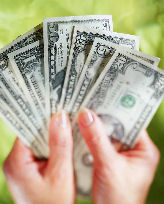 | |
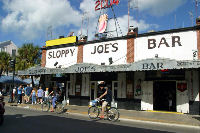 | |
Bankable Bar Bets
$ Three nuns attended the conclave of 1939.
$ The Chief Rabbi in Rome, Israel Zolli, converted to Catholicism shortly after the war.
$ The papacy and the U.S. both campaigned for the Christian Democrat (DC) party in the first Italian election of 1948. The DC won, but the Communists received 31 percent of the votes. The pope excommunicated everyone who voted for the latter.
$ After World War II Pope Pius XII lobbied to commute the sentences of German war criminals.
$ A bishop in the Vatican helped several notorious Nazi war criminals escape prosecution. There is some evidence that Pope Pius XII might have known about the so-called “Ratline.”
$ Pope Pius XII had the same housekeeper for approximately forty years. Sister Pascalina Lehnart organized all of his affairs.
$ The most commonly spoken language in the papal apartments during the papacy of Pope Pius XII was German.
$ Pope Pius XII had the hiccoughs for five years.
$ Pope Pius XII had pet birds with German names. They were allowed to fly around loose while he was eating his meals.
$ Pope Pius XII reported that he saw the “miracle of the sun” on four different occasions.
$ Jesus reportedly appeared to both Pope Pius XII and Rabbi Zolli.
$ Pope Pius XII decreed that Mary was assumed bodily into heaven.
$ Pope Pius XII endorsed the Big Bang theory and, to an extent, evolution.
$ A burly American bishop, Paulius Marcinkus, served as the bodyguard for Pope Paul VI. He saved the pontiff’s life when a Bolivian painter tried to stab Pope Paul in the Philippines. He later saved Pope John Paul II by disarming a disaffected Spanish priest.
$ Bishop Marcinkus took over the Vatican bank in 1971 and made many deals with two shady Italian financiers, both of whom were murdered. The Vatican paid more than two hundred million dollars for its role in the schemes. Marcinkus was indicted by the Italian legal system but protected by the Vatican.
$ Pope Paul VI evidently thought that the devil had infiltrated the Vatican.
$ Pope John Paul II set many pontifical records: 104 trips outside of Italy, 231 new cardinals, 1,340 beatifications, 480+ canonizations.
$ Pope John Paul II was the only pope to have been shot. He survived the attack for twenty-four years, but he never regained his vigor.
$ The Vatican Bank evidently provided the Solidarity Trade Union with millions of dollars.
$ The Vatican did not rank the pope’s two visits with President George W. Bush among the top 535 events of the papacy of John Paul II.
